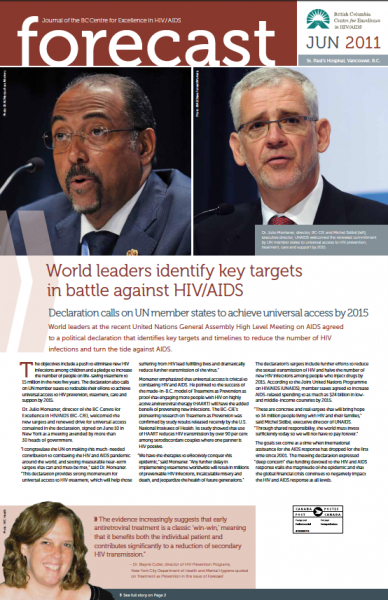World leaders identify key targets in battle against HIV/AIDS
Declaration calls on UN member states to achieve universal access by 2015
 World leaders at the recent United Nations General Assembly High Level Meeting on AIDS agreed to a political declaration that identifies key targets and timelines to reduce the number of HIV infections and turn the tide against AIDS.
World leaders at the recent United Nations General Assembly High Level Meeting on AIDS agreed to a political declaration that identifies key targets and timelines to reduce the number of HIV infections and turn the tide against AIDS.
The objectives include a push to eliminate new HIV infections among children and a pledge to increase the number of people on life-saving treatment to 15 million in the next five years. The declaration also calls on UN member states to redouble their efforts to achieve universal access to HIV prevention, treatment, care and support by 2015.
Dr. Julio Montaner, director of the BC Centre for Excellence in HIV/AIDS (BC-CfE), welcomed the new targets and renewed drive for universal access contained in the declaration, signed on June 10 in New York at a meeting attended by more than 30 heads of government.
“I congratulate the UN on making this much-needed contribution to combating the HIV and AIDS pandemic around the world, and setting measurable near-term targets that can and must be met,” said Dr. Montaner. “This declaration provides strong momentum for universal access to HIV treatment, which will help those suffering from HIV lead fulfilling lives and dramatically reduce further transmission of the virus.”
Montaner emphasized that universal access is critical to combating HIV and AIDS. He pointed to the success of the made-in-B.C. model of Treatment as Prevention as proof that engaging more people with HIV on highly active antiretroviral therapy (HAART) will have the added benefit of preventing new infections. The BC-CfE’s pioneering research on Treatment as Prevention was confirmed by study results released recently by the U.S. National Institutes of Health. Its study showed that use of HAART reduces HIV transmission by over 90 per cent among serodiscordant couples where one partner is HIV positive.
“We have the therapies to effectively conquer this epidemic,” said Montaner. “Any further delay in implementing treatments worldwide will result in millions of preventable HIV infections, incalculable misery and death, and jeopardize the health of future generations.”
The declaration’s targets include further efforts to reduce the sexual transmission of HIV and halve the number of new HIV infections among people who inject drugs by 2015. According to the Joint United Nations Programme on HIV/AIDS (UNAIDS), member states agreed to increase AIDS-related spending to as much as $24 billion in low- and middle-income countries by 2015.
“These are concrete and real targets that will bring hope to 34 million people living with HIV and their families,” said Michel Sidibé, executive director of UNAIDS. “Through shared responsibility, the world must invest sufficiently today so we will not have to pay forever.”
The goals set come at a time when international assistance for the AIDS response has dropped for the first time since 2001. The meeting declaration expressed “deep concern” that funding devoted to the HIV and AIDS response trails the magnitude of the epidemic and that the global financial crisis continues to negatively impact the HIV and AIDS response at all levels.
